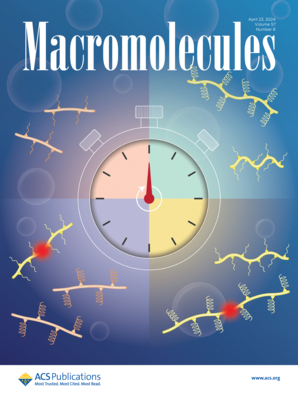Resolving the Mystery of the Extraordinary Polyelectrolyte Behavior (Anomalously Slow Diffusive Mode) after Half-Century of Research
IF 5.1
1区 化学
Q1 POLYMER SCIENCE
引用次数: 0
Abstract
Half a century ago, the presence of an anomalously slow diffusive mode in polyelectrolyte solutions (extraordinary behavior) was mentioned for the first time. The transition from high-salt to low-salt conditions was referred to as the “ordinary–extraordinary transition.” It was related to the appearance of large structures in solution appreciably exceeding the sizes of individual polyions despite like-charges on polyions and monovalent counterions. Despite appreciable experimental effort, no clear explanation of the origin of this phenomenon was reached, while existing theories of like-charge attraction were not able to explain experimental data. This work brings a resolution to this long-standing puzzle, although some questions remain still open. It is shown that there are two types of submicrometer-sized objects that occur simultaneously in polyelectrolyte solutions and contribute to the slow diffusive mode. Since their size distributions are very similar, it was not possible to identify them so far on the basis of simple scattering experiments. The first type of object originates from hydrophobic molecules commonly present in polyelectrolytes as unwanted admixtures, which (1) adhere to uncharged polymer chains; (2) are stripped from the chains upon ionization; (3) aggregate in water; and (4) the aggregation process stops at a mesoscale level because of developing a surface ζ-potential. These mesoscale particles/droplets can then be removed from solution by filtration, providing a practical method for the purification of polyelectrolytes to ultrahigh purity. Objects of the second type occur even in solutions of hydrophobe-free polyelectrolytes and give a substantially weaker scattering signal. Their unexpected characteristics are described, but still more data are needed to exactly unveil their origin. This work brings a new paradigm in the interpretation of older and future data, realizing that the acquired data represent mostly a mixture of contributions from two different mechanisms, which must be separated in order to be meaningfully analyzed and interpreted. Experiments in this work were performed on synthetic polyelectrolytes representing polyanions, polycations, strong polyelectrolytes, and weak polyelectrolytes, respectively.

求助全文
约1分钟内获得全文
求助全文
来源期刊

Macromolecules
工程技术-高分子科学
CiteScore
9.30
自引率
16.40%
发文量
942
审稿时长
2 months
期刊介绍:
Macromolecules publishes original, fundamental, and impactful research on all aspects of polymer science. Topics of interest include synthesis (e.g., controlled polymerizations, polymerization catalysis, post polymerization modification, new monomer structures and polymer architectures, and polymerization mechanisms/kinetics analysis); phase behavior, thermodynamics, dynamic, and ordering/disordering phenomena (e.g., self-assembly, gelation, crystallization, solution/melt/solid-state characteristics); structure and properties (e.g., mechanical and rheological properties, surface/interfacial characteristics, electronic and transport properties); new state of the art characterization (e.g., spectroscopy, scattering, microscopy, rheology), simulation (e.g., Monte Carlo, molecular dynamics, multi-scale/coarse-grained modeling), and theoretical methods. Renewable/sustainable polymers, polymer networks, responsive polymers, electro-, magneto- and opto-active macromolecules, inorganic polymers, charge-transporting polymers (ion-containing, semiconducting, and conducting), nanostructured polymers, and polymer composites are also of interest. Typical papers published in Macromolecules showcase important and innovative concepts, experimental methods/observations, and theoretical/computational approaches that demonstrate a fundamental advance in the understanding of polymers.
 求助内容:
求助内容: 应助结果提醒方式:
应助结果提醒方式:


